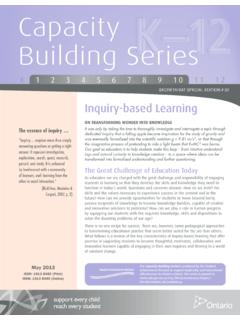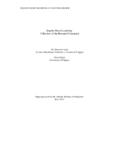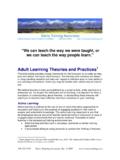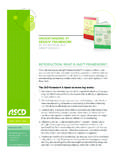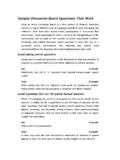Transcription of 4.6. Neuromythologies 4.6.1. Separating science …
1 learning Seen from a Neuroscientific Approach 69 OECD Separating science from speculationWith the advent of functional imaging technology, cognitive neuroscience is begin-ning to produce important research on the neural foundations of cognitive research results have sparked a tremendous amount of commentary and specula-tion among scientists, researchers, education specialists, and policy-makers. Since suchresearch proves to have merit, many want to know how educational practice can beimproved or enriched by the application of these research As a result of bothpressure to improve overall school performance and excitement and interest about edu-cation that could be brain- based , many myths and misconceptions have arisen around themind and brain outside of the scientific community.
2 Teachers and educational specialistsare eager to put into practice what they have read in the popular press,59 and policy-58. Not only educational practices, but also everyday parenthood may benefit fromresearch findings. In fact, parents are an important market for (..) this brain information is on the television, in the newspapers, in the magazines:what does it mean for the classroom teacher? (Mark Fletcher, during the Granadaforum). [The teachers] hear a lot about their subjects, about mathematics or biology, orwhatsoever, but they really have a big lack in neuroscientific and psychological learningtheories. I think we should look into this direction and ask what teachers could learnfrom cognitive neuroscience.
3 (Dr. Heinz Schirp during the Granada forum.)Teachers, of course, are not neuroscientists, but it is both understandable and desirable thatthey look to the work of neuroscientists to help them improve teaching. Given that those whopromulgate brain- based education to teachers fail to also convey the relative paucity ofresearch to support their claims, teachers might be tempted to too readily adopt so-called brain- based teaching strategies that are in fact not based on any evidence at all. The scien-tific community should be sensitive to these issues. A challenge, therefore, is to strengthenpedagogical knowledge and strategies by inviting teachers to a) share their knowledge amongthemselves and b) share this knowledge with the neuroscientific community.
4 Thus, the neuro- science community will be able to ground some of its research questions within the authenticexperiences of good teachers. Hence, it is necessary to educate the public about both thegains due to cognitive neuroscience, but also the need to focus on simple questions aboutelementary processes first. There is of course a lot of work to do in order to integrate insightsabout elementary processes into the complex context faced by educators. Furthermore, edu-cators can play a key role in helping identify such questions, that might be tractable for neuro-scientists (see the Granada report on the OECD website, op. cit.). understanding the Brain: Towards a New learning science 70 OECD 2002makers want to enact effective educational policy by using research- based infor-mation.
5 Even business is eager to commercialise on what is perceived of financialinterest in brain- based learning tools. Due to the expectations of the applicabilityof brain research to educational practice, myths have rapidly developed andrange from the benefit of synaptogenesis, to hemisphere dominance, to criticalperiods of learning and enrichment to name the most popular ones. When mis-conceptions such as these are both argued for and criticised in journals and thepopular press, educators and policy-makers alike are left in a quandary discerningfact from fiction. Although some myths do have some truth to them, careful read-ing of the original research from where they came from demonstrates that thisresearch has often either been misinterpreted (simplified) or based exclusivelyon animal studies with limited implications for human In the past, most scientists have claimed that at birth, the human brainhas all the neurons it will ever have.
6 However, with the advent of new technol-ogies, this fact is being challenged. Some mechanisms, such as those that con-trol our basic survival instincts are in place at birth, but most of the new-bornsmental circuitry results from experiences how and when these connectionsare formed is a subject of debate. Some scientists argued that these circuitsare completed by age 3, others believed that they continue until adolescence;more recently, a consensus seems to emerge, implying that synaptic connec-tions are formed throughout the life cycle. This emerging and recent consensuscan have profound implications as to the way the education system goal of this section is to explain the origin of some of the more preva-lent myths that the public has, to highlight why they are detrimental and/ornon-effective for educational practice and to discuss how best to interpret sci-entific data.
7 The decade 1990-2000 was declared the Decade of the Brain in theUnited States. At the same time, world-wide research on the cognitive andemotional functioning of the brain has been Although much ofthis research has been of very high quality, some of its findings have beenover-interpreted in terms of their implications for learning . Such examples arepresented While animal studies have proved essential and necessary in understanding someaspects of human development, caution must be exercised when applying results ofexperimental data to human learning and cognition. More generally, history shows thatestablishing parallels between animal and human behaviour without exercising extremecaution can prove misguided, if not This is just one example where political vision has encouraged scientific research and,beyond, started to influence educational change through appropriate Seen from a Neuroscientific Approach 71 OECD 2002 Neuroscientific results must be taken as preliminary in nature for several reasons: Their statistical results might not be of the highest relevance (subtractionmethod and averaging62).
8 Results on the same subject can differ due to methodological and theoreticalconsiderations. The laboratory setting might not be the appropriate place to test a skill as itis an unnatural and contrived setting. A single study cannot justify a certain classroom strategy. In the popular press, in order to appeal to the greatest number of people,often the reporting of brain research is over-simplified; this is the origin ofalmost all misconceptions and misunderstandings about science . Some current claims about the neuroscientific basis for learning must beapproached with a healthy dose of skepticisim. Current and emerging technolo-gies produce both interesting and promising results, but these will prove evenmore relevant and useful for education if previous misconceptions and misbeliefsabout science are eradicated.
9 The genesis of a neuromyth usually starts with a misunderstanding, a mis-reading and in some cases a deliberate warping of the scientifically establishedfacts to make a relevant case for education or for other purposes. There are threepopular myths discussed in this chapter: hemisphere dominance or specialisa-tion, synaptic development and learning , critical periods and enrichment(including the myth of birth to three).62. These methods are considered somewhat weak, because comparing two differentresults that might share some elements in common will not clarify the differencesbetween the two results. In neuroimaging data, for example, condition A is one task andcondition B is another, different, task.
10 In order to find the differences between them toascertain which condition activates a particular brain area, the subtraction method isoften used. This consists of looking at all the activation points on one image due tocondition A and then looking at all the activation points on another image due tocondition B. If the two conditions are really different, one can reason that subtractingone image from another will show only those areas in the brain pertinent to a particularcondition. The problem with this method is that from one condition to another, thebrain does not necessarily stop its activation from the previous condition just becausethe condition has ended (sometimes there s a residue of activation) and sometimesboth conditions will activate the same brain areas.










